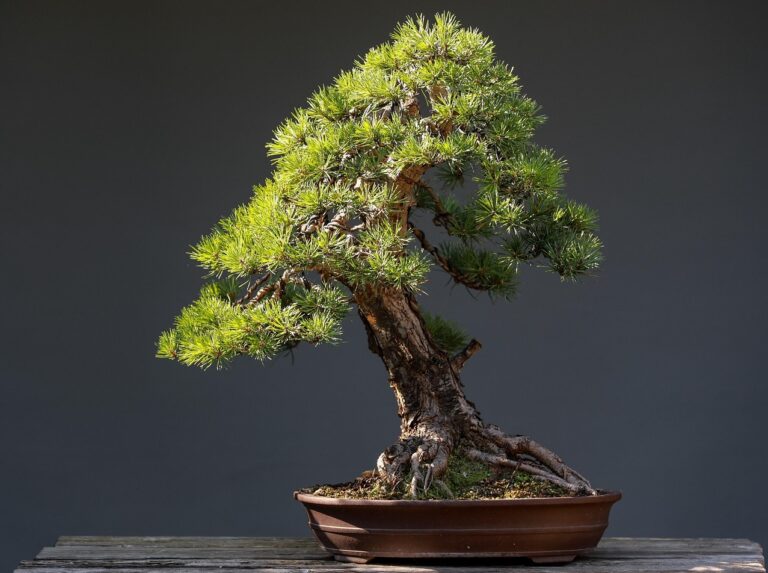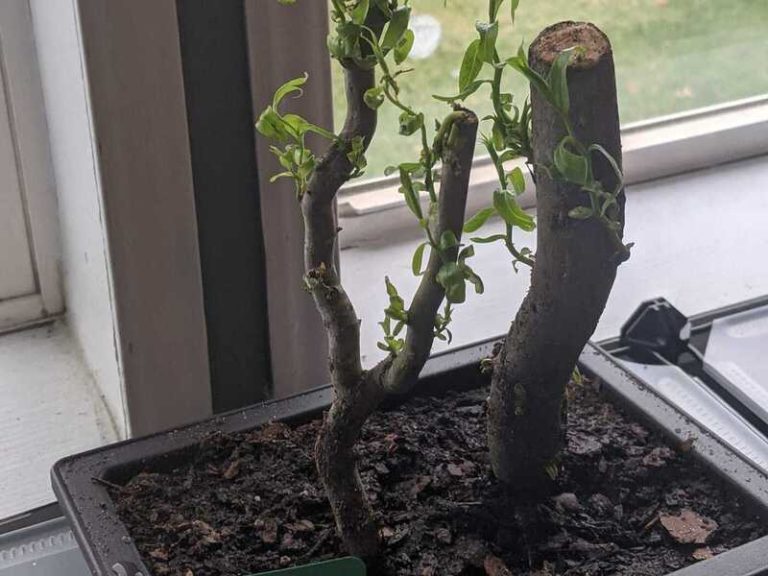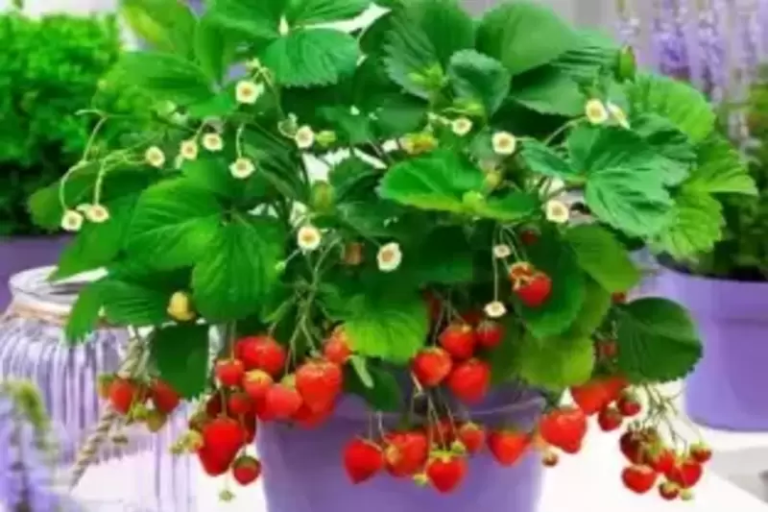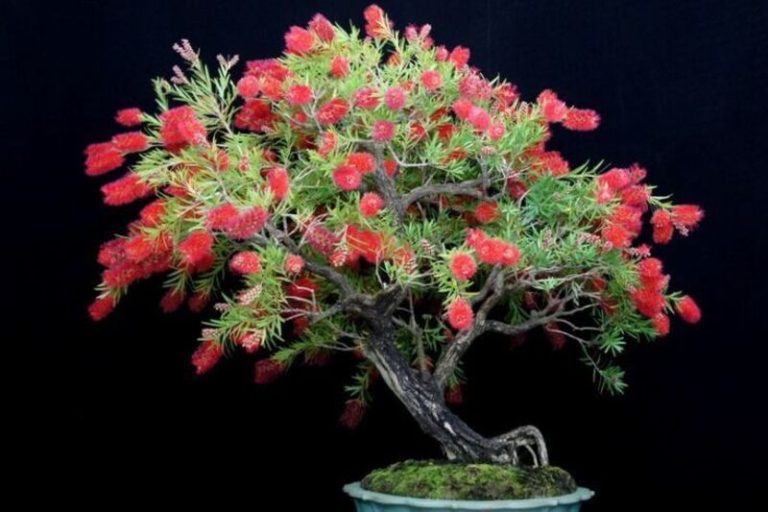Manzanita Bonsai: A Delicate Art Form with Lasting Beauty
Manzanita bonsai trees are both popular and stunningly gorgeous. These miniaturized Manzanita trees are ideal for bonsai care. We will walk you through the process of developing and caring for your own Manzanita bonsai to ensure that it thrives and flourishes in this post.
What is Manzanita Bonsai?
Manzanita bonsai is a miniature version of the Manzanita tree, a native North American plant. These bonsai trees have unique gnarled trunks and attractive reddish-brown bark. They are highly valued for their natural beauty and make captivating additions to bonsai collections. Growing and caring for Manzanita bonsai involves specific techniques like potting, pruning, watering, and providing appropriate sunlight. With proper care, Manzanita bonsai can thrive and showcase the stunning characteristics of their full-sized counterparts.
History and Origins of Manzanita Bonsai
The history and origins of Manzanita bonsai can be traced back to the practice of bonsai itself, which originated in ancient China over a thousand years ago. Bonsai, which translates to “tree planting,” involves cultivating and training trees in miniature form, creating living works of art.
Manzanita trees, from which Manzanita bonsai are derived, are native to North America, primarily found in the western coastal regions. These trees belong to the genus Arctostaphylos and have a rich history in the natural landscape.
Manzanita tree bonsai cultivation most likely evolved as an outgrowth of the larger bonsai practice. As the art of bonsai moved beyond China and into other regions of the world, such as Japan, enthusiasts and artists tried to investigate and adapt different tree species to produce bonsai examples.
Manzanita, with its unique and intriguing characteristics, captured the attention of bonsai enthusiasts. Its distinctive gnarled trunks, attractive bark, and fascinating growth patterns made it an ideal candidate for bonsai cultivation.
Over time, the art of growing Manzanita bonsai evolved and spread, with bonsai artists refining techniques and styles specific to these trees. In today’s world, bonsai enthusiasts value and cultivate Manzanita bonsai for both its natural beauty and the artistic challenge it offers.
Manzanita bonsai’s history and beginnings are inextricably linked to the history of bonsai as an art form, and its cultivation reflects a blend of natural beauty, creative expression, and horticultural competence.
Types of Manzanita Bonsai
There are various Manzanita species that are often utilized to make Manzanita bonsai. Each species has distinct features and attributes that lend itself to bonsai growth. Here are some examples of popular Manzanita bonsai:
Arctostaphylos manzanita: This is the most commonly used species for Manzanita bonsai. It features twisted branches, attractive reddish-brown bark, and small oval-shaped leaves. Arctostaphylos manzanita bonsai are known for their rugged and gnarled appearance.
Arctostaphylos densiflora: Also known as Vine Hill Manzanita, this species has an upright growth habit and a dense canopy of dark green leaves. It produces beautiful clusters of pink or white flowers, adding to its overall aesthetic appeal as a bonsai.
Arctostaphylos uva-ursi: Commonly known as Bearberry or Kinnikinnick, this species is known for its low-growing habit and small, leathery leaves. It often forms dense, compact mats of foliage, making it suitable for creating cascading or rock-style bonsai.
Arctostaphylos hookeri: This species, also called Hooker’s Manzanita, features twisted and contorted branches that add an element of drama to the bonsai. It has smooth, reddish-brown bark and small, dark green leaves.
These are only a handful of the many Manzanita species that may be utilized for bonsai horticulture. Each species has its own distinct beauty and traits, allowing bonsai lovers to discover and develop their own magnificent Manzanita bonsai trees.
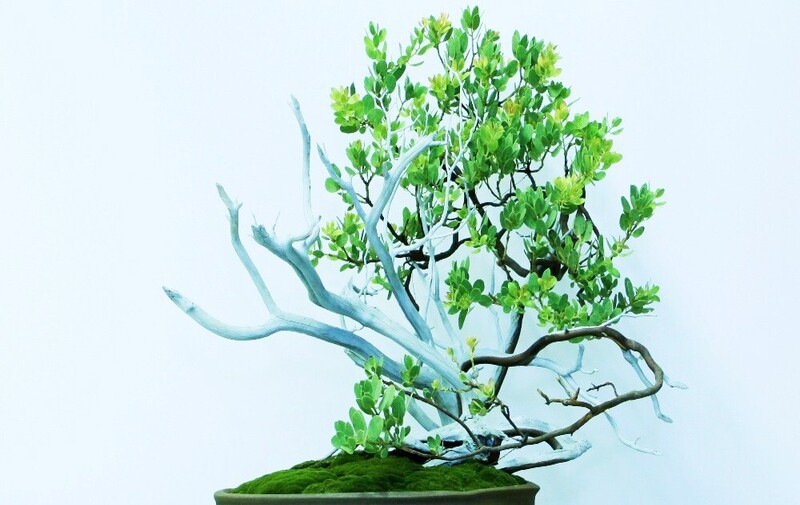
Manzanita Bonsai and its Symbolism
Manzanita bonsai, like many other types of bonsai, carries symbolic meaning and represents various concepts in different cultures. Here are some common symbolic associations and meanings attributed to Manzanita bonsai:
Endurance and Strength: Manzanita bonsai’s gnarled trunks and twisted branches represent perseverance and fortitude. These trees frequently flourish in tough areas with strong winds and difficult weather. They serve as a reminder of tenacity and the capacity to overcome adversity as bonsai.
Beauty in Simplicity: Manzanita bonsai, with their minimalist beauty and elegant form, embody the concept of beauty in simplicity. The tree’s refined and delicate features evoke a sense of harmony and tranquility, reflecting the principles of minimalism and the appreciation of understated beauty.
Longevity and Wisdom: Bonsai, including Manzanita bonsai, are often associated with longevity and wisdom. The art of bonsai requires patience and careful nurturing over many years to achieve a well-developed and mature tree. The longevity of Manzanita bonsai represents the passage of time and the accumulation of wisdom and experience.
Connection to Nature: Manzanita bonsai trees, being miniature representations of their full-sized counterparts in nature, serve as a connection to the natural world. They remind us of the beauty and wonder of the natural environment and encourage a deeper appreciation for nature’s intricate designs and processes.
Zen and serenity: The art of bonsai, notably Manzanita bonsai, is frequently connected with Zen philosophy and the desire of inner peace and harmony. The thought and care necessary for a bonsai tree may be calming and grounding, offering a sense of tranquility and connection to the present moment.
It’s important to note that symbolism can vary across cultures and individuals, and personal interpretations and associations with Manzanita bonsai may differ. Ultimately, the symbolic meaning of a Manzanita bonsai is subjective and can be deeply personal to the observer or cultivator.
Characteristics of the Manzanita Bonsai
Manzanita bonsai trees possess distinct characteristics that make them unique and visually appealing. Here are some key features and traits of the Manzanita bonsai:
Gnarled Trunks: Manzanita bonsai are known for their gnarled trunks, which exhibit intricate twists, turns, and contortions. The twisting and curving of the trunk add a sense of age, character, and artistic interest to the bonsai tree.
Attractive Bark: The bark of the Manzanita bonsai is one of its standout features. It has a reddish-brown coloration that can vary from species to species. The bark peels off in thin strips, revealing a smooth and visually appealing surface underneath. The combination of color and texture of the bark adds visual interest and enhances the overall aesthetics of the bonsai.
Small Oval-shaped Leaves: Manzanita bonsai leaves are generally tiny, oval-shaped, leathery, and glossy in appearance. The leaves are typically dark green, however this varies according on the species. The foliage gives the bonsai tree with a lush and green canopy.
Intriguing Branching Patterns: The branching patterns of Manzanita bonsai are often irregular and captivating. They feature twisted, angular, and asymmetrical branches that add visual complexity and dynamic energy to the overall design of the tree.
Compact Size: Manzanita bonsai are naturally compact in size, making them suitable for growing in containers. Their smaller stature allows them to be easily displayed indoors or on tabletops, adding an element of natural beauty to any space.
Drought-tolerant: Manzanita trees, and consequently, Manzanita bonsai, are adapted to dry and arid conditions. They are naturally drought-tolerant and can withstand periods of limited watering. This characteristic makes them well-suited for bonsai cultivation, as they require less frequent watering compared to some other species.
Overall, the Manzanita bonsai exhibits a blend of ruggedness, elegance, and natural beauty. Its unique characteristics, such as gnarled trunks, attractive bark, and intriguing branching patterns, contribute to its visual allure and make it a captivating choice for bonsai enthusiasts.
How to Grow Manzanita Bonsai
Manzanita bonsai cultivation necessitates close attention to certain techniques and concerns. Here’s how to cultivate Manzanita bonsai step by step:
Species Selection: Choose the appropriate Manzanita species for bonsai cultivation. Popular choices include Arctostaphylos manzanita, Arctostaphylos densiflora, Arctostaphylos uva-ursi, and Arctostaphylos hookeri. Consider the desired size, growth habit, and aesthetics of the species before making a selection.
Potting: Select a suitable pot for your Manzanita bonsai. Ensure the pot has drainage holes to prevent waterlogging. Use well-draining bonsai soil or a mix of akadama, pumice, and lava rock to promote good airflow and prevent root rot.
Repotting: Repot your Manzanita bonsai every two to three years during the early spring, just before new growth emerges. Trim the roots and remove old soil to encourage healthy root development. Be gentle with the roots, as Manzanita bonsai may be sensitive to root disturbance.
Pruning and Shaping: Regular pruning is crucial for maintaining the shape and health of your Manzanita bonsai. Remove any dead, damaged, or crossing branches. Use wiring and clip-and-grow techniques to shape the branches and create the desired bonsai form. Prune in late winter or early spring, before the onset of new growth.
Watering: Manzanita bonsai prefer well-drained soil. Water the tree thoroughly when the top inch of soil feels slightly dry. Avoid overwatering, as Manzanita trees are adapted to drier conditions. Monitor the moisture levels and adjust watering accordingly.
Sunlight: Manzanita bonsai flourish under direct sunlight. Place your bonsai in an area where it will receive a minimum of six hours of direct sunlight per day. Provide supplemental illumination with grow lamps if growing indoors to ensure adequate light exposure.
Fertilizing: Fertilize your Manzanita bonsai during the growing season, typically from spring to early autumn. Use a balanced, slow-release organic fertilizer or a bonsai-specific fertilizer. Follow the package instructions for application rates and frequency.
Temperature and Climate: Certain species of Manzanita bonsai may have distinct temperature preferences than others. Make sure your bonsai is exposed to temperatures within its optimal range. Protect it from extreme weather or heat, particularly in the winter and summer.
Pests and Diseases: Monitor your Manzanita bonsai for pests such as aphids, spider mites, or scale insects. Treat any infestations promptly using appropriate methods like insecticidal soap or horticultural oils. Ensure good airflow and proper hygiene practices to prevent fungal diseases.
Regular Maintenance: Regularly inspect your Manzanita bonsai for any signs of stress, disease, or pests. Prune and wire as needed to maintain the desired shape. Repot when necessary, following proper techniques. Provide ongoing care and attention to keep your Manzanita bonsai healthy and thriving.
Remember, growing Manzanita bonsai requires patience and observation. Adjust your care routine based on the specific needs of your bonsai and its response to different environmental factors. With time and proper care, you will witness the beauty of your Manzanita bonsai as it develops into a stunning miniature tree.
Benefits of Manzanita Bonsai
Manzanita bonsai offer several benefits that make them a popular choice for bonsai enthusiasts. Here are some key benefits of cultivating Manzanita bonsai:
- Aesthetic Appeal: Manzanita bonsai trees are visually captivating and possess unique and intriguing characteristics. Their gnarled trunks, attractive bark, and twisted branches create a natural and artistic beauty that can enhance any indoor or outdoor space.
- Compact Size: Manzanita bonsai are naturally small in size, making them ideal for those with limited space or who prefer indoor gardening. Their compactness allows them to be easily displayed on tabletops, shelves, or bonsai stands, adding a touch of natural beauty to any environment.
- Low Maintenance: Manzanita bonsai are relatively low-maintenance compared to other varieties of bonsai trees. Once established, they are drought-resistant and require less frequent irrigation. Additionally, they require little fertilizer and can flourish in a variety of climates.
- Connection to Nature: Cultivating Manzanita bonsai provides a connection to nature in miniature form. It allows individuals to appreciate the beauty of trees and the natural world in a compact and manageable setting, even in urban environments.
- Artistic Expression: Manzanita bonsai offer a creative outlet for bonsai enthusiasts. The process of shaping and pruning the tree allows individuals to express their artistic vision and create unique bonsai designs. The contorted branches and unique growth patterns of Manzanita bonsai offer endless possibilities for artistic interpretation.
- Relaxation and Mindfulness: Caring for Manzanita bonsai can be a calming and meditative experience. The process of tending to the bonsai, such as pruning, wiring, and watering, encourages mindfulness and provides an opportunity to unwind and reduce stress.
- Educational and Learning Experience: Growing Manzanita bonsai is an excellent way to learn about horticulture, tree biology, and bonsai art. It provides the chance to cultivate forbearance, observational skills, and a deeper understanding of the natural world.
- Conversation Starter: Manzanita bonsai can serve as a conversation starter and a point of interest in social settings. The unique appearance and beauty of the bonsai tree can spark conversations about nature, gardening, and the art of bonsai.
Because of these things, growing Manzanita bonsai is a fun and satisfying hobby for both expert and new bonsai growers. They are a popular choice in the world of bonsai because they look nice, don’t need much care, and can be used to show art.
Styling and Design of Manzanita Bonsai
When it comes to styling and design, Manzanita bonsai offer a wide range of creative possibilities. The unique characteristics of Manzanita trees, such as their gnarled trunks and twisted branches, make them ideal for creating dramatic and visually striking bonsai designs. Here are some styling and design options for Manzanita bonsai:
Informal Upright Style: The informal upright style, or moyogi, is a common choice for Manzanita bonsai. This style mimics the natural growth habit of the tree, with a slightly curved trunk and branches that radiate in all directions. Emphasize the tree’s unique twists and turns to create an organic and dynamic design.
Cascade Style: The cascade style, or kengai, is another option for Manzanita bonsai. This style portrays a tree growing on a steep slope, with the trunk cascading downward. Utilize the natural cascading habit of Manzanita branches to create a sense of movement and drama.
Windswept Style: The windswept style, or fukinagashi, can showcase the resilience of Manzanita bonsai. This design resembles a tree whose branches have bowed in one direction due to strong winds. Arrange the branches in a way that conveys a sense of motion and creates a dynamic visual impact.
Multiple Trunk Style: Manzanita bonsai often have multiple trunks emerging from the base, offering an opportunity to create a multi-trunk bonsai design. Select and shape the trunks to create an interesting composition that highlights the unique branching patterns and adds depth to the overall design.
Group Planting: Manzanita bonsai can also be used in group plantings, known as forest or group styles. Combine multiple Manzanita bonsai trees of varying heights and shapes to create a miniature forest scene. Arrange the trees in a visually pleasing manner, considering their unique characteristics and maintaining balance within the composition.
Deadwood Features: Manzanita bonsai can incorporate deadwood features, such as weathered or hollowed-out sections of the trunk or branches. These deadwood elements add age, character, and visual interest to the bonsai design, enhancing its overall aesthetic appeal.
Accentuating Bark and Branches: The distinctive reddish-brown bark and twisted branches of Manzanita bonsai make them excellent candidates for showcasing these features. Highlight the attractive bark with gentle cleaning and polishing. Position and shape the branches to create interesting and visually appealing compositions.
Remember, styling and design choices for Manzanita bonsai should be based on the tree’s natural characteristics and your artistic vision. Study the tree’s unique growth patterns, experiment with different wiring techniques, and consider the principles of bonsai design, such as balance, proportion, and harmony. With creativity and careful execution, you can create stunning and captivating designs that showcase the beauty of your Manzanita bonsai.
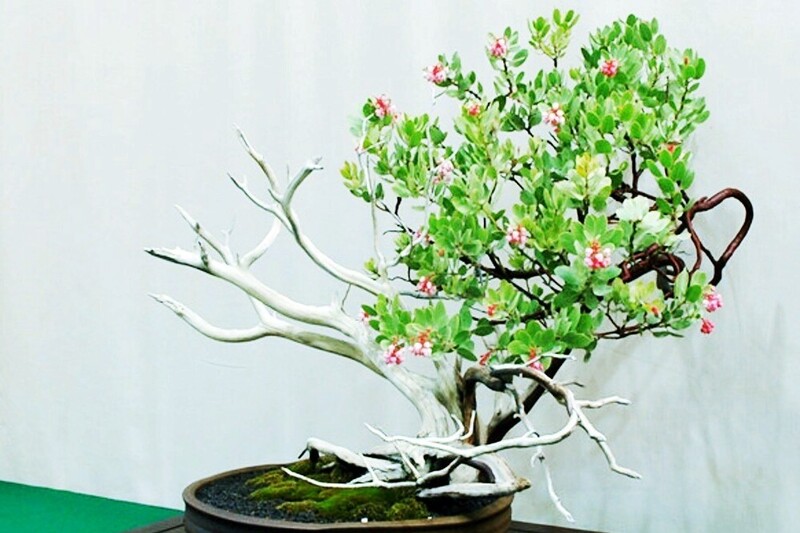
How to Care for a Manzanita Bonsai
Proper care is essential for maintaining the health and vitality of a Manzanita bonsai. Here are some key care guidelines to ensure your Manzanita bonsai thrives:
- Sunlight: Manzanita bonsai require ample sunlight to thrive. Place your bonsai in a location that receives at least six hours of direct sunlight each day. If growing indoors, provide supplementary lighting using grow lights to ensure adequate light exposure.
- Watering: Manzanita bonsai prefer well-drained soil. Water the tree thoroughly when the top inch of soil feels slightly dry. Avoid overwatering, as Manzanita trees are adapted to drier conditions. Monitor the moisture levels and adjust watering accordingly. During hot and dry periods, you may need to water more frequently.
- Soil: Use well-draining bonsai soil or a mix of akadama, pumice, and lava rock to promote good airflow and prevent root rot. Avoid heavy soils that retain excessive moisture. Repot your Manzanita bonsai every two to three years, trimming the roots and refreshing the soil mix.
- Pruning: Regular pruning is important to maintain the shape and health of your Manzanita bonsai. Remove any dead, damaged, or crossing branches. Prune in late winter or early spring, before the onset of new growth. Avoid heavy pruning, as Manzanita trees may be slow to recover.
- Fertilizing: Feed your Manzanita bonsai during the growing season, typically from spring to early autumn. Use a balanced, slow-release organic fertilizer or a bonsai-specific fertilizer. Follow the package instructions for application rates and frequency. Avoid overfertilizing, as it can lead to excessive growth and weaken the tree.
- Temperature and Climate: Because of these things, growing Manzanita bonsai is a fun and satisfying hobby for both expert and new bonsai growers. They are a popular choice in the world of bonsai because they look nice, don’t need much care, and can be used to show art.
- Pest and Disease Control: Monitor your Manzanita bonsai for pests such as aphids, spider mites, or scale insects. Treat any infestations promptly using appropriate methods like insecticidal soap or horticultural oils. Ensure good airflow and proper hygiene practices to prevent fungal diseases.
- Protection from Winds: Manzanita bonsai are naturally adapted to windy conditions, but excessive wind can dry out the foliage and stress the tree. Provide wind protection during severe weather conditions by moving the bonsai to a sheltered location or using windbreaks.
- Regular Inspection and Maintenance: Regularly inspect your Manzanita bonsai for any signs of stress, disease, or pests. Prune and wire as needed to maintain the desired shape. Repot when necessary, following proper techniques. Provide ongoing care and attention to keep your Manzanita bonsai healthy and thriving.
By following these care guidelines and providing the necessary attention, you can enjoy the beauty and longevity of your Manzanita bonsai. Remember that each bonsai is unique, and adjusting care routines based on the specific needs of your tree will contribute to its overall health and well-being.
Manzanita bonsai Care Sheet
| Aspect | Care Tips |
| Sunlight | Place in a location with at least 6 hours of direct sunlight daily. Provide supplementary lighting for indoor bonsai. |
| Watering | Water when the top inch of soil feels slightly dry. Avoid overwatering. Monitor moisture levels. |
| Soil | Use well-draining bonsai soil or a mix of akadama, pumice, and lava rock. Repot every 2-3 years. |
| Pruning | Regularly prune to maintain shape and health. Remove dead, damaged, or crossing branches. Prune in late winter or early spring. |
| Fertilizing | Feed during the growing season with a balanced, slow-release organic or bonsai-specific fertilizer. Follow instructions for application rates and frequency. |
| Temperature and Climate | Ensure temperature is within the preferred range of the specific Manzanita species. Protect from extreme cold or heat. |
| Pest and Disease Control | Monitor for pests and treat infestations promptly. Ensure good airflow and hygiene to prevent diseases. |
| Protection from Winds | Provide wind protection during severe weather conditions. Move to a sheltered location or use windbreaks. |
| Regular Inspection | Regularly inspect for signs of stress, disease, or pests. Prune and wire as needed. Repot when necessary. |
By following these care tips and considering the specific needs of your Manzanita bonsai, you can provide the best possible care for its health and growth.
Conclusion:
Growing and caring for Manzanita bonsai is a rewarding journey. By following these simple steps, you can enjoy the beauty of these miniature trees in your own space. Start your Manzanita bonsai adventure today and witness the remarkable transformation of nature’s beauty right before your eyes. For more information and guidance, explore additional resources dedicated to bonsai cultivation.
FAQ:
Q: What is a Manzanita bonsai?
A: A Manzanita bonsai is a miniature tree that is cultivated and shaped in the bonsai style using a Manzanita tree species, known for its unique characteristics and twisted branches.
Q: How often should I water my Manzanita bonsai?
A: Water your Manzanita bonsai when the top inch of soil feels slightly dry, but avoid overwatering as they prefer well-drained soil.
Q: Can I keep my Manzanita bonsai indoors?
A: While Manzanita bonsai can be kept indoors, they generally thrive when grown outdoors. If kept indoors, ensure they receive ample sunlight or provide supplementary lighting.
Q: How do I shape the branches of my Manzanita bonsai?
A: Prune in late winter or early spring to shape the branches, removing dead or crossing branches. Wiring can also be used to guide branches into desired positions.
Q: Is winter protection necessary for Manzanita bonsai?
A: Manzanita bonsai are generally cold-hardy, but extreme cold temperatures can damage them. Provide protection during severe winter weather.
Q: How do I prevent pests and diseases in my Manzanita bonsai?
A: Regularly inspect for pests and treat infestations promptly. Maintain good airflow and hygiene to prevent fungal diseases.
Q: When should I repot my Manzanita bonsai?
A: Repot every two to three years in early spring before new growth starts. Trim the roots and refresh the soil mix.
Q: Can I collect Manzanita from the wild for bonsai?
A: Collecting from the wild should be done responsibly and with proper permissions. It’s best to source from reputable nurseries or bonsai growers.
Q: How long does it take for a Manzanita bonsai to develop?
A: Manzanita bonsai generally require several years to develop the desired shape and maturity, but it can vary based on the tree’s age and starting size.
Also Read:


